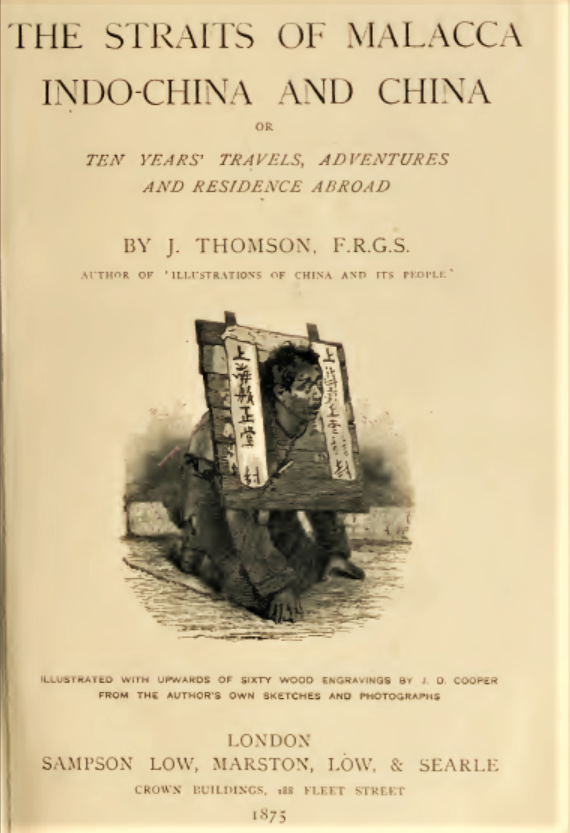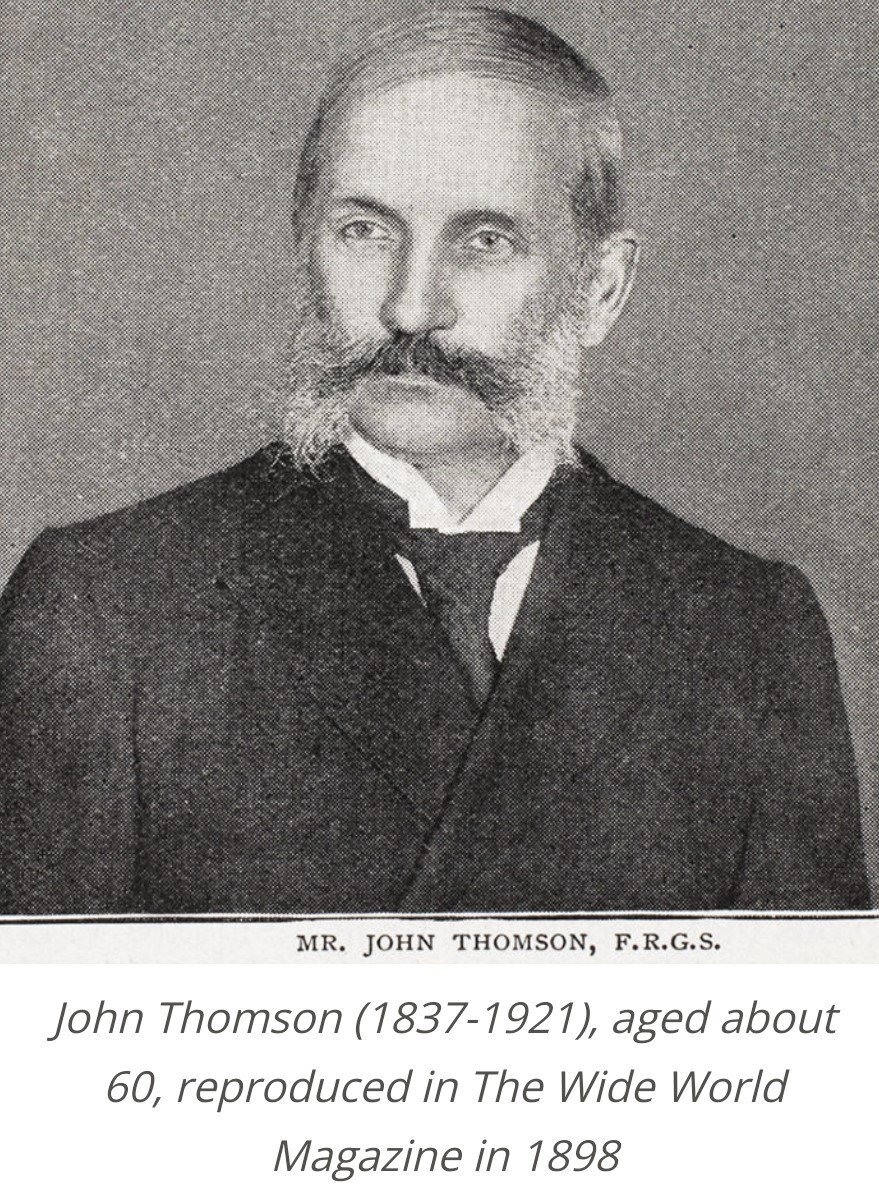The Straits of Malacca, Indochina and China or Ten Years' Travels, Adventures and Residence Abroad
by John Thomson
Or Ten Years' Travels, Adventures and Residence Abroad

- Format
- on-demand books
- Publisher
- Sampson Low, Marston, Low & Searle, London
- Edition
- Digital Version by Archive.org
- Published
- 1875
- Author
- John Thomson
- Pages
- 546
- Language
- English
John Thomson’s recollection of his years in Southeast Asia and China remains an essential reference for historians and travelers. Among the numerous insights the author shares with us, we shall stress out:
- About Chulalongkorn (King Rama V, Phra Chula Chom Klao Chao Yu Hua, จุฬาลงกรณ์, 20 Sept. 1853 – 23 Oct. 1910):
Siam has greatly changed since the time of my visit to that country. The first and second Kings have both been gathered to their fathers, and their sons now reign in their stead. Antiquated laws and objectionable customs have passed out of date, and a liberal policy is being steadily pursued. Slavery has been abolished, and the custom of crouching in the presence of a superior has been discontinued by the express order of the Sovereign. His majesty lately visited Singapore and Calcutta, and the experiences which he gained there seem to have been taken to heart. The education which this young King received from the English Governess, Mrs. [Anna] Leonowens, at his father’s court, must have had its effect in forming his character, while constant intercourse with foreigners, together with his own manly ambition to make the most of his inheritance, have all contributed to render his career an exceptional one in the history of his country. One might almost suppose that he has in his veins some of the blood of those ancient Cambodian rulers who built their marvellous cities and temples, who conquered and subdued the surrounding countries, and founded for themselves a mighty empire, of which no traces save their stone monuments remain.
- About Siem Reap and the fact that Angkor remained an important Buddhist pilgrimage destination at that time:
The Chow Muang of Nakhon Siamrap received us with great courtesy, placing a house at our disposal for two or three days, until a Laos chief, who had come with a considerable escort on a pilgrimage to Nakhon Wat, should have started on his homeward journey, and left room for our accommodation. The old town of Siamrap is in a very ruinous state — the result, as was explained to us, of the last invasion of Cambodia — but the high stone walls which encircle it are still in excellent condition. Outside these fortifications a clear stream flows downwards into the great lake some fifteen miles away, and this stream, during the rainy season, contains a navigable channel.
- About his first impression at Angkor Wat and his personal survey of the structure:
The vast proportions of the temple filled me with a feeling of profound awe, such as I experienced some
years afterwards when sailing beneath the shade of the gigantic precipices of the Upper Yang-tsze.
The secret of my emotion lay in the extreme contrast between Nakhon Wat — rising with all the power
which magnitude of proportions can give, a sculptured giant pyramid amid forests and jungle-clad plains — and
the grass-thatched huts, the rude primitive structures which are all that the present inhabitants have either
wish or ability to set up. Nakhon Wat, like the majority of the buildings of ’ Inthapatapuri ’ and the other
cities of Cambodia, is raised upon a stone platform. It is carried upward from its base in three quadrangular
tiers, with a great central tower above all, having an elevation of 180 feet. The outer boundary wall encloses
a square space measuring nearly three-fourths of a mile each way, and is surrounded by a ditch 230 feet
across. This ditch is spanned on the west by the causeway (already described), having sculptured flights of stone steps leading to the water. These were probably intended for the first ablutions of the worshippers at this Brahminical or Buddhist shrine. Facing the cardinal points of the compass, and in the centre of each side of the boundary wall, there are long galleries with arched roofs and monolithic pillars, which present a striking and classical appearance. Entering the main gateway through the western boundary, and passing up a broad inner causeway, paved like the outer one with blocks of polished freestone, we approach the western front of the temple proper. Ascending to a cruciform terrace by a flight of steps sculptured with the most beautiful ornaments, and guarded on either side by colossal stone lions, we stand before the principal entrance of the shrine. The façade on this side is more than six hundred feet in length, and is walled in, in the centre, for a distance of some two hundred feet. This walled space is divided into compartments, and each compartment is lighted with windows. In every window there are seven ornamental stone bars, uniform in pattern and in size throughout. The floral ornamentation on these bars appear to represent the sacred lotus, and the flowers are as carefully repeated as if they had been cast from a single mould. These compartments recur in the centre of all the galleries; the remaining two-thirds of the space always consisting of open colonnades, the back walls of which are adorned with the bas-reliefs which form one of the chief attractions of Nakhon Wat. (p 136 – 7)
- About his visit to Phnom Penh Royal Palace:
The King treated us with great courtesy, assigning us a house within the palace grounds, and entertaining us repeatedly at his table, where excellent dinners were specially prepared for us in completely European style. The fact is, his majesty had a French cook in his pay ; and this was the secret of a culinary skill which at first took us somewhat by surprise. These dinners were a real enjoyment, for we had not had a good meal for some time ; as my readers will understand when I tell them that at Nakhon Wat — thinking: we should be all the better for some strengthening food, and not being familiar with the American plan of cutting a steak as we required it, and keeping the animal going alive — we had to purchase a whole bullock to secure a joint of beef. The animal afforded us about three good meals, and caused us to be looked upon as demons by the devout Buddhists for slaying an ox. We then tried to preserve portions of the carcase, but it was a failure. His majesty honoured us with a long performance of his dancing women. However, it was truly a tedious affair when the first novelty of the exhibition had worn off.
Tags: Western explorers, travelogue, Siam, 19th century, Cambodia, 1860s, 1870s
About the Author

John Thomson
Scottish photographer and geographer John Thomson (14 June 1837, Edinburgh – 29 Sept. 1921, Edinburgh) was a pioneer in photographying the ruins of Angkor in 1866, part of his ten-year long travel stint across Asia after joining his elder brother William in Singapore in 1862.
When he left for the Far East, he had studied photography processing and technique as an apprentice in an optical and scientific device manufacturing company, while enrolling to evening classes at Watts Institution and School of Arts to study chemistry, philosophy and geography.
Thomson was welcomed at the Court of Siam in 1865, and then to Phnom Penh Royal Palace the following year. After Cochinchina and Indochina, he traveled around China, documenting local cultures, landscapes and artefacts of the East. He insisted to travel to Angkor, with the assistance of his friend H.G. Kennedy, a British Consulate officer fluent in Siamese, after reading Henri Mouhot’s travel accounts, first published in English even if Mouhot was a French citizen.
According to Jim Mizerski in Cambodia Captured, “On January 27, 1866, John Thomson accompanied by H. G. (Henry George) Kennedy left Bangkok on his way to Angkor. His departure was noted in the Bangkok Recorder:
Mr. Thomson, the photographer who has been residing in Bangkok approximately three months, departed last Saturday, 11th day of the waxing moon in the third month, headed for Cambodia, to the ancient city of Angkor, wishing to photograph those ancient artifacts for the European people to see. Mister Thomson went by land, not by way of Chanthaburi. He expects to return in two months. During those two months anyone wishing to see the photographs taken in Bangkok may do so. The photographs are with Captain Ames, Commander of the Police, whose home is at Pom Pongpajamid. The king praised Mr. Thomson as a truly excellent photographer. I agree that none can compare to him.
In The Straits of Malacca, John Thomson recorded the start of his Cambodian adventure:
We had first intended to sail down the Gulf of Siam to Chantaboon, and thence to cross over the forest-clad mountains of that province to Battabong. But the Siamese Government declined to grant a passport for that route, which they reported as dangerous and impracticable. We were therefore reduced to the necessity of making a tedious, and, so far as health was concerned, more dangerous journey by the creeks and rivers, and across the hot plains and marshes of the south-eastern provinces of the interior.
Thomson’s original plan to follow a shortened version of Henri Mouhot’s route was not possible and his adventure in Cambodia was to be uniquely his own. There is nothing to suggest that Thomsen’s plan, at least at the time he left Bangkok, included traveling to Phnom Penh and Kampot, which he later did.
After his Asian period, he worked on the street people of London, deveoping a style of social documentary viewed as the historic basis of modern photojournalism. Yet he was at ease in all strata of society, to the point that he became portrait photographer of the Mayfair High Society, with a Royal Warrant granted to him in 1881. He had a great impact on his contemporaries, for instance introducing the famous travel writer Isabella Lucy Bird to the art of photography.
See the short online biography by the National Library of Scotland.


